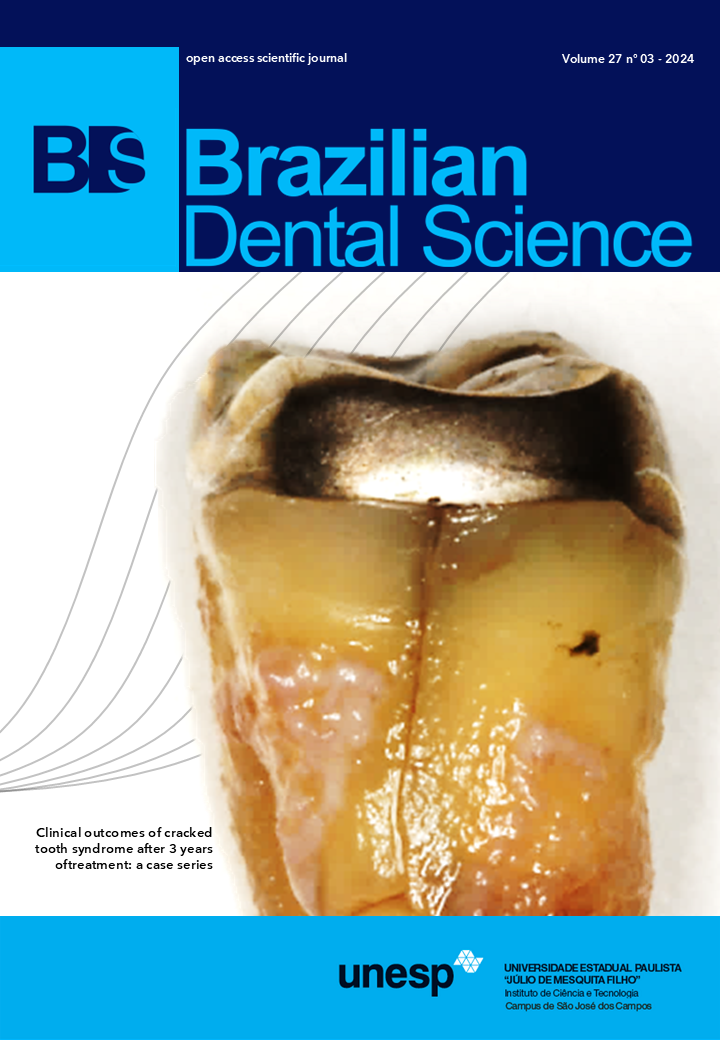Water sorption and color stability of dental composites light-cured with a broadband LED device and different radiant exposures
DOI:
https://doi.org/10.4322/bds.2024.e4379Resumen
Objective: This study assessed the properties of four resin-based composites (Charisma Classic, Charisma Diamond, Filtek Z350XT, and Filtek Bulk Fill) concerning water sorption and color stability under different radiant exposures of a broadband LED device (Valo Cordless, Ultradent) and immersion solutions. Material and Methods: Disc-shaped specimens of the composites were prepared and subjected to two different radiant exposures: 20 J/cm2 at 1000 mW/cm2 for 20 seconds and 16.8 J/cm2 at 1400 mW/cm2 for 12 seconds. Water sorption (SO) was measured using a precision weighing scale, while color stability (deltaE00) was evaluated after immersion in distilled water, coke soft drink, or beer for 28 days. Factorial ANOVA and Tukey HSD test (alpha = 5%) were employed for data analysis. Results: Significant differences were observed in water sorption (p = 0.000) among the composites and radiant exposures (p = 0.022). Likewise, color stability (deltaE00) exhibited significant differences among composites (p = 0.000), radiant exposures (p = 0.000), and immersion solutions (p = 0.000). Interaction between factors was also significant (p = 0.000). Conclusion: Radiant exposure significantly impacts the properties of resin-based composites, particularly affecting water sorption and color stability. Optimal performance in clinical settings can be achieved by tailoring polymerization conditions. The study found that exposure to 20 J/cm2 at 1000 mW/cm2 for 20 seconds resulted in the lower water sorption values, while the lowest color alteration (deltaE00) was observed with 16.8 J/cm2 at 1400 mW/cm2 for 12 seconds.
KEYWORDS
Color; Composite resins; Curing lights; Dental restoration; Esthetics.
Descargas
Descargas
Publicado
Cómo citar
Número
Sección
Licencia
Derechos de autor 2024 Brazilian Dental Science

Esta obra está bajo una licencia internacional Creative Commons Atribución 4.0.
Brazilian Dental Science uses the Creative Commons (CC-BY 4.0) license, thus preserving the integrity of articles in an open access environment. The journal allows the author to retain publishing rights without restrictions.
=================
COPYRIGHT TRANSFER AND RESPONSIBILITY STATEMENT
(PDF)
For all articles published in the BDS journal, copyright is retained by the authors. Articles are licensed under an open-access Creative Commons CC BY 4.0 license, meaning that anyone may download and read the paper for free. In addition, the article may be reused and quoted, provided that the original published version is cited. These conditions allow for maximum use and exposure of the work while ensuring that the authors receive proper credit. All metadata associated with published articles is released under the Creative Commons CC0 Universal Public Domain Dedication.
Before the submission, authors must obtain permission to reproduce any published material (figures, schemes, tables, or any extract of a text) that does not fall into the public domain or for which they do not hold the copyright. Permission should be requested by the authors from the copyright holder (usually the Publisher, please refer to the imprint of the individual publications to identify the copyright holder).
The authors hereby attest that the study is original and does not present manipulated data, fraud, or plagiarism. All names listed made a significant scientific contribution to the study, are aware of the presented data, and agree with the final version of the manuscript. They assume complete responsibility for the ethical aspects of the study.
This text must be printed and signed by all authors. The scanned version should be submitted as supplemental file during the submission process.




























